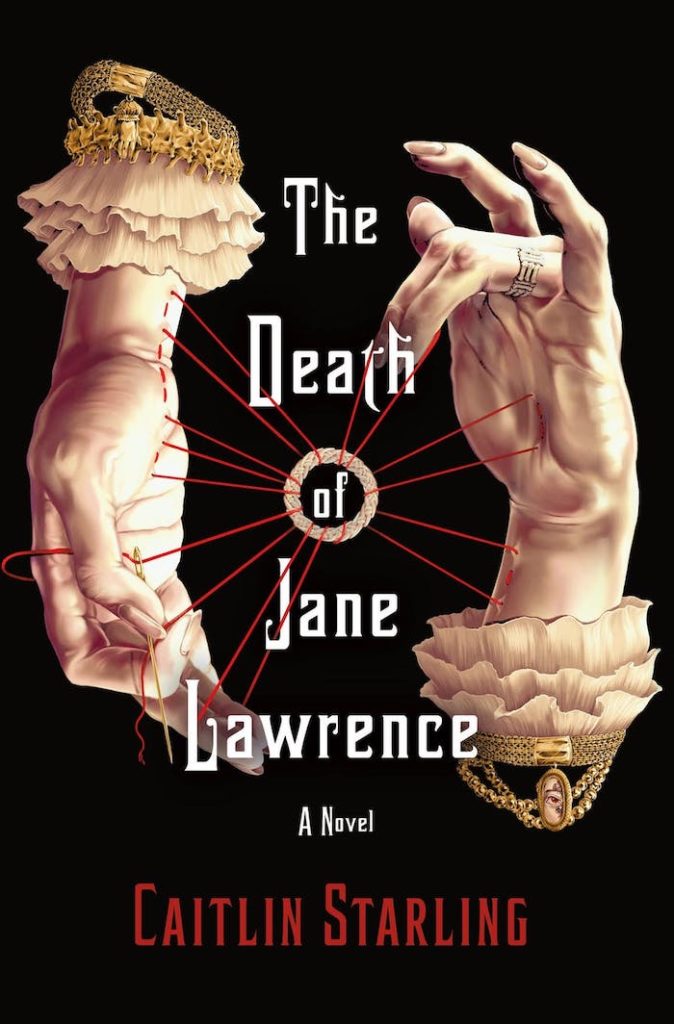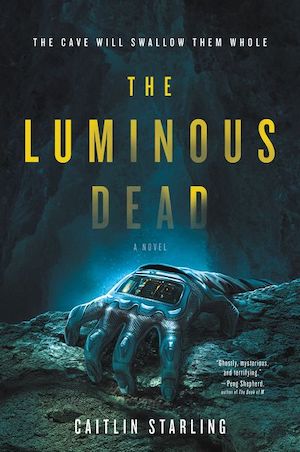Haunted, abandoned spaceships. A castle besieged by zombies. Ravenous mermaids waiting for the Titanic to sink. Whether it’s Alien’s science fiction setting or The VVitch’s pitch-perfect historical grounding, horror has a long tradition of playing in other genres’ sandboxes. Everywhere the human imagination can go, dread and terror can follow.
My first novel, The Luminous Dead, falls squarely in the Alien tradition: in space, no one can hear you scream. Our protagonist, Gyre, explores a dangerous cave system, forced to rely entirely on another woman aboveground who has complete control over the suit that keeps Gyre alive (and has a penchant for lying whenever it suits her murky goals). The horror is inseparable from the setting. It can’t exist outside of a science fictional space.

By contrast, The Death of Jane Lawrence leans into the historical along well-trod lines: it is primarily and recognizably a work of gothic horror first, complete with a setting that is at least adjacent to Victorian England. While the points at which the setting of Great Breltain diverges from reality are all specifically and intentionally chosen, they won’t, for the average reader, ping as speculative right off the bat.
In fact, making it strictly historical might have been the safer choice. Writing horror in crossover spaces has a certain inherent risk of failure, and the more speculative those spaces are, the greater the risk. From the first, you’re going to turn away some readers who don’t already feel comfortable in and interested by your setting or viewpoint of choice. (I’ve heard more than once that readers have been hesitant to pick up The Luminous Dead because they don’t think they’re “smart enough” for science fiction–which, huge can of worms right there, but that’s for a different discussion). There can be psychological barriers to entry even before we get to the specifics of the story you’re trying to tell.
So why do it? Because horror is inescapable. It is chameleonic, taking on the flavors of its surroundings. And there are new, tantalizing questions to explore in other settings.
The trick, then, is in learning how to keep crossover horror approachable–and scary.
Keep it simple.
The more you explain something, the less scary it is.
Particularly at the start, too much information too fast kills the mood. Details should unspool slowly, piece by piece. This is important: giving a reader all the knowledge to understand an unfamiliar world upfront is going to make them feel comfortable, or it might frustrate them. And too much comfort or frustration are the enemy of dread.
Generally speaking, dread comes from not knowing exactly what to expect. It is the quiet moment before the monster attacks; the footsteps in the hall before the shadow crosses the threshold. Dread lives in a liminal space, half-glimpsed, inevitable. Particularly when it comes to setting details, like the history of a country, or the current technological landscape, broad strokes do a lot more to provide darkened corners for implications to fester. This flies in the face of what many people enjoy about less familiar historical settings, or fantastical ones. Many of us read fantasy for the magic systems, the world-building. The nuance and creativity of a science fiction book’s technology can make or break it. But when horror gets added to the mix, you have to be careful. Introduce only those elements that are absolutely necessary to follow the story, and introduce them slowly.
Like all storytelling, horror relies on schemas: mental constructs that a reader may already have and may already fear. This is one major reason why a large portion of horror is set in a contemporary replica of our world (through the lens of general commercial appeal). If your premise starts with a cabin in the woods and a bunch of college students on vacation, the audience will come in with a particular set of assumptions and expectations. You can then either subvert those, or just use the space created by not having to explain them to add on other, more specific details.
By contrast, when we venture into other settings (or revisit familiar settings from different viewpoints, but that’s a topic for yet another entirely different essay), we lose access to some, but not all, of these schemas. But we can still count on the reader to intrinsically fear some malicious force gaining entry to a spaceship (a modification of a home invasion), being stranded far from help (not that different from being stranded at sea), or depressurizing in the vacuum of space (similar to drowning or being buried alive).
Which leads us to our next trick:
Balance the horror of the recognizable with the horror of the new.
We can build directly on the expectations of our audience in order to introduce new things without adding (too much) complexity.
Let’s play with our science fiction-horror crossover a little. Some fears that aren’t immediately familiar, but are specific to a space setting, can be easily grasped, like the risk of signal degradation or manipulation. The exact explanation may take a moment to understand, but then we can connect it to an existing fear like a strange voice on our phone, or photos appearing on our camera that we couldn’t have taken. If I tell you how something fantastical works by connecting it to technology you’re already familiar with, that familiarity will make you anticipate (at least subconsciously) what generally can go wrong with it, even if the specifics will surprise you.
But what if we want to play with entirely new fears that derive entirely from the setting? At their core, these too can (and should) tap into existing fears, but the “entrance fee” to reach those fears is higher.
Let’s say, for instance, that space travel requires passing through zones which induce amnesia, but within this world, that’s not inherently frightening. Everybody crewing or traveling on a ship knows to expect this, and there are systems put in place to minimize complications and distress. It’s as commonplace as jetlag.
Instead, what’s terrifying in this setting is when somebody doesn’t forget.
In order to make your audience fear this on a gut level, you’ll need to spend time and worldbuilding assuring them that forgetting is entirely safe. You’ll need to demonstrate their reflexive fears don’t apply, and it will probably take a while to counteract that knee-jerk reaction. Then, and only then, can you come through and upend their expectations all over again. It can work, but the more elements like these you build into a tale, the harder it will be to maintain tension without causing frustration.
While it may be tempting to eschew all multi-step scenarios like our “remembering space travel” concept, that’s not what I’m advocating for either. Some of crossover horror’s greatest opportunities come from introducing new concepts and taking them to their logical conclusions. The challenge isn’t to avoid these concepts, but to curate them carefully enough that our readers will follow along for the ride. Pick and choose what you’re going to need your audience to learn, and what they can just assume about your setting. Surprise, but don’t frustrate.
One last note: try to build in scares that become more horrifying the more specialized knowledge a potential reader has. The VVitch, for instance, benefits from but does not require in-depth knowledge of the historical period in which it’s set. Ignorance doesn’t negate the mounting dread, and understanding makes it worse, not better. It suggests new things to anticipate and fear, and provides added depth to the existing text.
Which leads us to trick number three:
Love both genres.
This is hopefully the most self-evident “trick” on this list. If you’re going to write science fiction horror, or fantasy horror, or historical horror, or horror romance (yes, this is a thing!), you should do it out of love for both genres. No horror is easy, I’ll just add it to my space opera, please! Or vice versa. You should be familiar enough with the toys you’re borrowing that you can twist and spin them into just the right arrangement to terrify your readers.
To be clear, love does not mean adore uncritically. But what it does mean is have respect for its readers, and interest in its mechanics, even if you intend to push them to their limits or flip them on their heads.

All of my works, to date, have existed somewhere in the realm of crossover horror, and each has taken a slightly different approach. To some extent, The Luminous Dead is science fiction only due to the technology Gyre relies on. Since the whole book takes place inside one cave that (with one notable exception) possesses no deeply unfamiliar flora or fauna, the other trappings of the genre can seem far away. Yes, she’s on a colony planet that is not Earth. Yes, space ships exist, and her mother left on one years ago. Galactic economics drive Gyre’s decision to lie about her credentials to get the job, but all of that can feel like window dressing to a true science fiction lover. Except for the suit.
The suit balances on the knife’s edge of amazing assistive device and hellish torture. Without it, Gyre will die. With it, her handler can control her entire body, and its computers can distort what she’s seeing. The experience of not just wearing that suit, but living in it, makes all the window dressing suddenly viscerally real and relevant. Without the suit, there is no story, and with the suit, I can pour in all the expansive possibilities, good and terrifying, that science fiction gives us.
The Death of Jane Lawrence, by contrast, sits somewhere in between fantasy horror and historical horror, leaning (at least at first glance) strongly toward the latter. But openly embracing elements of fantasy (magic, an almost steampunk-like remixing of technological history, an unfamiliar cosmology) allowed the book to blossom into something entirely its own.
Freeing it from the restrictions of a strictly historical setting allowed me to create an alternate pseudo-England where technology was firmly in the late 1800s, but something akin to WWII had happened within recent memory, with the capital city bombed out and an entire generation left scarred from WWI-era chemical weapons. It also let me play fast and loose with the trappings of esoteric ritual magic without needing to cleave to the frustratingly and inescapably Orientalist roots of the real tradition. By pulling on techniques from alternate-history fantasy, I could make the magic more solid, more real, while still maintaining the nightmarish one-step-left-of-real feeling of the existing gothic canon.
Any scenario can become horrific; there are too many things that scare us, that threaten our survival and our sense of self. Build new worlds, and fill them with the unsettling, the grotesque, the terrifying. Just give your audience a path to follow–so that you can yank them right off it once they get comfortable.



